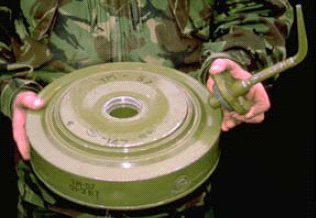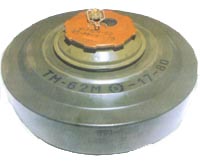
The Tellermine 42 (T.Mi.42) was a German metal-cased anti-tank blast mine used during the Second World War. The mine was a development of the Tellermine 35 with improved resistance to blast. It was followed by the simplified Tellermine 43.

The TM-57 mine is a large, circular Soviet metal-cased blast anti-tank mine. It can either be triggered by a pressure or a tilt-rod fuze. A development of the TM-46 mine, it is found in Africa, the Middle East, and South East Asia.

The M15 mine is a large circular United States anti-tank blast mine, first used during World War Two. Essentially, it is a larger version of the M6A2 anti-tank mine, which it replaced. Although the M15 has been superseded by the M19 mine, the U.S. retains large stocks of M15s because they are still regarded as reliable and effective weapons. When used against main battle tanks the M15 is primarily a "track-breaker" which creates mobility kills, but has a comparatively small likelihood of causing crew fatalities. However, when used against lighter vehicles such as APCs or unarmored vehicles such as trucks the damage inflicted is much more severe.

The VS-1.6 is an Italian circular plastic-cased scatterable anti-tank blast mine. It has very few metal components and is resistant to overpressure and shock. The mine can also be deployed conventionally and from helicopters. It was produced by Valsella Meccanotecnica, but production has ceased.

The VS-50 is a circular plastic cased anti-personnel blast mine, formerly manufactured by the now-defunct Valsella Meccanotecnica SpA, an Italian high-tech defence industry specialized in area denial systems which was also the manufacturer of the Valmara 69 and one of the first industries in the world to implement plastic construction for landmines. The design is similar to the TS-50 and VS-MK2 mine. It is blast resistant and can be used in a minimum metal configuration. Though unlikely to kill, the explosive charge contained within a VS-50 is quite sufficient to destroy the victim's foot: the blast is capable of penetrating 5 mm of mild steel leaving an 80 mm-diameter hole.
The M7 is a small, metal-cased United States anti-tank blast mine that was used during the Second World War. It was based on the British Hawkins grenade. Approximately 2.5 million were produced before production ceased, and although it has long since been withdrawn from U.S. service, it can be found in Angola, Burma, Cambodia, Chad, Eritrea, Ethiopia, Korea, Lebanon, Myanmar, Somalia, Thailand, and Zambia.

TM-62 is the designation for a series of Soviet anti-tank blast mines. The mines have a central fuze and typically have a 7.5 kg explosive charge, however they vary greatly in detail. The mines can be laid manually or automatically from a mine laying machine including the PMR-1, PMR-2 wheeled towed mine layers, the GMZ tracked mine laying vehicle and the VMR-2 helicopter mine laying system.
The SB-81 is an Italian plastic cased minimum metal anti-tank blast mine dating from the early 1980s. The mine uses an air pressure based fuze, which gives it protection against overpressure and blast. It can therefore be regarded as a blast resistant mine. The mine can be scattered by hand or by mine laying systems.
The Type 63 AT mine is a large circular Japanese minimum metal anti-tank blast mine. The mine does not float and is waterproof, enabling it to be used in shallow water. The mine uses a standard mechanical pressure fuze, with three ball bearings retaining a spring-loaded striker over a detonator assembly. The Type 63B variant has a secondary fuze well to attach an anti-handling device.
The VS-AT4 and VS-AT4-EL are Italian minimum metal blast resistant anti-tank blast mines. The VS-AT4 uses a blast-resistant mechanical pressure fuze, while the VS-AT4-EL uses a programmable electronic pressure fuze with an integral anti-lifting function.

The TC/2.4 is a circular plastic cased Italian minimum metal anti-tank blast mine. The mine uses a blast and shock resistant pneumatic fuze. It could be laid by hand or mechanically, and could be fitted with anti-handling devices. An Egyptian copy of the mine is produced, designated as the M/80. The mine was used in Iraq, but is no longer produced.
The PTM-80P is a circular plastic bodied Bulgarian minimum metal anti-tank blast mine, similar in design to the Russian TM-62P2. The mine can accept any fuze that fits into the TM-62 series of mines, including various mechanical, blast resistant, electronic, and magnetic influence fuzes. The mine is completely waterproof and can be laid in shallow water. It is currently in service with the Bulgarian armed forces.
The NR 25 is a circular Dutch steel cased anti-tank blast mine. It is broadly similar in appearance to the German Tellermine 43, although it is larger. The mine has a central domed pressure plate, underneath which is an NR-29 mechanical pressure fuze, which is inserted into a fuze well. A doughnut-shaped main charge surrounds a central booster charge. Two secondary fuze wells are provided on the side and base of the mine, for anti-handling devices.
The MKT Mod 72 is an Albanian circular, metal-cased anti-tank blast mine, a copy of the Russian TM-46. Two versions of the mine are produced, the PX designated version of the mine is fitted with a secondary fuze well in the base of the mine that accepts an MUV type anti-lifting device. The mine uses a mechanical pressure fuze similar to the Russian MV-5.
The PT Mi-U is a circular Czech anti-tank mine with a Misznay Schardin effect warhead. It can be used with a conventional pressure fuze or a tilt rod fuze.
The VS-SATM1 is an Italian scatterable anti-tank landmine that was produced by Valsella Meccanotecnica SpA. The mine can be scattered by a GRILLO-128 man-portable single-tube launcher system or a VS-MDH helicopter based system. The mine has six pop-out fins which slow its descent and improve the dispersion characteristics.

The FFV 028 is a series of steel cased Swedish anti-tank mines that use electronic fuzes. The mines are circular, with a large Misznay Schardin effect warhead in the center of the mine, with the fuzing and sensor electronics located in the dead space above the main charge. The design of the mine dates from the 1970s and uses a magnetic influence sensor to detonate the mine, making it able to attack the full width of armoured vehicles.
In military munitions, a fuze is the part of the device that initiates function. In some applications, such as torpedoes, a fuze may be identified by function as the exploder. The relative complexity of even the earliest fuze designs can be seen in cutaway diagrams.
Adrushy Mk-II is an Indian anti-tank mine that features a shaped charge and a magnetic influence fuze. The mine is capable of discriminating between tanks and tank trawls using a sensor employing mutual induction.









